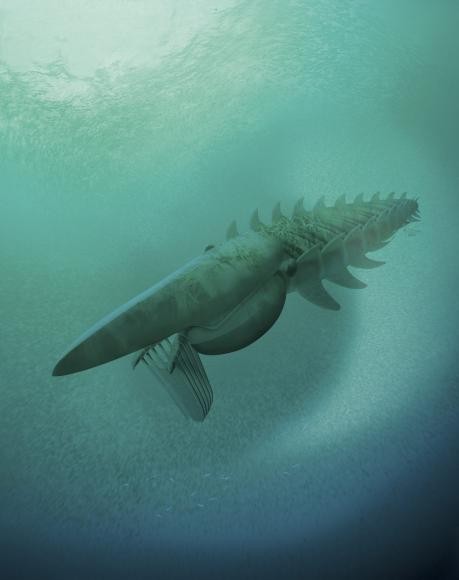Scientists Found Fossils of Giant Sea Monster
| Marco Foronda | | Mar 12, 2015 05:22 PM EDT |
(Photo : Reuters/Marianne Collins, ArtofFact/Handout via Reuters) The reconstruction of a filter-feeding Aegirocassis benmoulae from the Ordovician Period feeding on a plankton cloud.
Early ancestors of today's shrimp were huge yet peaceful creatures, suggests a new study that sheds light on these gentle giants that lived around 485 million years ago.
The newly described species is one of the largest arthropods yet discovered, a class of animals that includes spiders and crabs. The well-preserved remains of the multi-segmented creature are providing clues about how subsequent arthropods' legs may have evolved from the dozens of stubby flaps used to propel this beast through the water.
Like Us on Facebook
They creatures are called anomalocaridids, and they lived more like today's enormous baleen whales than modern tiny shrimp.
Fossils of the ancient leviathan were unearthed from 480 million year-old rocks exposed on a hillside in southeastern Morocco. Besides a handful of relatively complete remains, researchers recovered about 50 fragments that came from molted exoskeletons or decomposing carcasses before they were buried by sediment, said Peter Van Roy, a paleobiologist at Yale University.
The largest nearly complete specimen measures about 1.3 meters long but likely would have stretched 1.6 meters if intact, he notes. Based on the sizes of isolated fragments, some of the creatures probably were about two meters long.
It was likely the largest creature on Earth at the time, and only two other types of arthropods ever rivaled or exceeded it in size, the researchers report online today in Nature.
Researchers studied the remains of a particular anomalocaridid, Aegirocassis benmoulae. It grew to about seven feet long.
The study shows how ancient this method of feeding is. Today's clams, krill, sponges, baleen whales, certain sharks, flamingos, some ducks, and other animals are filter feeders. This marine beast, however, was an early ancestor of shrimp, other crustaceans, insects and spiders.
Each of the species' trunk segments has flaps that bears a resemblance to either walking limbs or gill flaps seen on the trunks of modern insects, spiders and crustaceans.
"This species is a very important intermediate, a transitional form," says Javier Ortega-Hernandez, a paleobiologist at the University of Cambridge in the United Kingdom, who wasn't involved in the research.
TagsScientists Found Fossils of Giant Sea Monster, evolution, Fossils, sea monster, arthropods, crustaceans, Ocean
©2015 Chinatopix All rights reserved. Do not reproduce without permission
EDITOR'S PICKS
-

Did the Trump administration just announce plans for a trade war with ‘hostile’ China and Russia?
-

US Senate passes Taiwan travel bill slammed by China
-

As Yan Sihong’s family grieves, here are other Chinese students who went missing abroad. Some have never been found
-

Beijing blasts Western critics who ‘smear China’ with the term sharp power
-

China Envoy Seeks to Defuse Tensions With U.S. as a Trade War Brews
-

Singapore's Deputy PM Provides Bitcoin Vote of Confidence Amid China's Blanket Bans
-

China warns investors over risks in overseas virtual currency trading
-

Chinese government most trustworthy: survey
-

Kashima Antlers On Course For Back-To-Back Titles
MOST POPULAR
LATEST NEWS
Zhou Yongkang: China's Former Security Chief Sentenced to Life in Prison

China's former Chief of the Ministry of Public Security, Zhou Yongkang, has been given a life sentence after he was found guilty of abusing his office, bribery and deliberately ... Full Article
TRENDING STORY

China Pork Prices Expected to Stabilize As The Supplies Recover

Elephone P9000 Smartphone is now on Sale on Amazon India

There's a Big Chance Cliffhangers Won't Still Be Resolved When Grey's Anatomy Season 13 Returns

Supreme Court Ruled on Samsung vs Apple Dispute for Patent Infringement

Microsoft Surface Pro 5 Rumors and Release Date: What is the Latest?










